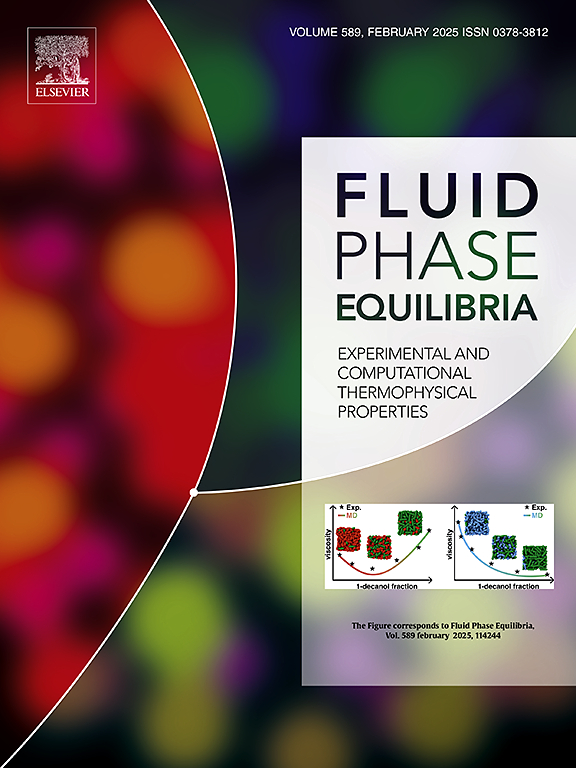Phase equilibria of carbon dioxide + sulfur hexafluoride mixed gas hydrate as fundamental data toward improving the mechanical properties of marine sediments
IF 2.8
3区 工程技术
Q3 CHEMISTRY, PHYSICAL
引用次数: 0
Abstract
Isothermal phase equilibria of carbon dioxide (CO2) + sulfur hexafluoride (SF6) mixed gas hydrate at temperatures of 281.85 K, 284.05 K, 288.05 K, 291.05 K, 291.74 K, and 292.20 K were measured so as to improve the mechanical properties of marine sediment by hydrate cementation. The addition of SF6 significantly reduces the equilibrium pressure of CO2-containing mixed gas hydrate at each temperature. At temperatures above the quadruple point Q2 (pure CO2 hydrate + aqueous + CO2-rich liquid + vapor phases) of 283.22 K, the four-phase (mixed gas hydrate + aqueous + guest-rich liquid + vapor phases) equilibrium point(s) exists(exist) on the isotherms of the CO2+SF6 mixed gas hydrate system. The four-phase equilibrium curve was connected from the quadruple point Q2 of pure CO2 hydrate to that of pure SF6 hydrate and had a maximum temperature point at 292.0 ± 0.2 K, which is higher than both the Q2 temperatures of pure CO2 hydrate and pure SF6 hydrate. Therefore, the addition of SF6 to CO2 brings a significant effect to expand the thermodynamically stable region of CO2-containing mixed gas hydrate in order for simultaneous CO2 storage and sediment improvement to be realized at marine sediment.

二氧化碳+六氟化硫混合气体水合物的相平衡是改善海洋沉积物力学性能的基础数据
测定了二氧化碳(CO2) +六氟化硫(SF6)混合气体水合物在281.85 K、284.05 K、288.05 K、291.05 K、291.74 K和292.20 K温度下的等温相平衡,目的是通过水合物胶结改善海洋沉积物的力学性能。SF6的加入显著降低了各温度下含co2混合气体水合物的平衡压力。当温度高于283.22 K的四点Q2(纯CO2水合物+水相+富CO2液体+气相)时,在CO2+SF6混合气体水合物体系的等温线上存在四相(混合气体水合物+水相+富guest液体+气相)平衡点(s)。四相平衡曲线由纯CO2水合物的四点Q2与纯SF6水合物的四点Q2相连,其最高温度点为292.0±0.2 K,高于纯CO2水合物和纯SF6水合物的Q2温度。因此,在CO2中加入SF6对扩大含CO2混合气体水合物的热力学稳定区域,实现海洋沉积物中CO2的同时储存和改善底质具有显著的作用。
本文章由计算机程序翻译,如有差异,请以英文原文为准。
求助全文
约1分钟内获得全文
求助全文
来源期刊

Fluid Phase Equilibria
工程技术-工程:化工
CiteScore
5.30
自引率
15.40%
发文量
223
审稿时长
53 days
期刊介绍:
Fluid Phase Equilibria publishes high-quality papers dealing with experimental, theoretical, and applied research related to equilibrium and transport properties of fluids, solids, and interfaces. Subjects of interest include physical/phase and chemical equilibria; equilibrium and nonequilibrium thermophysical properties; fundamental thermodynamic relations; and stability. The systems central to the journal include pure substances and mixtures of organic and inorganic materials, including polymers, biochemicals, and surfactants with sufficient characterization of composition and purity for the results to be reproduced. Alloys are of interest only when thermodynamic studies are included, purely material studies will not be considered. In all cases, authors are expected to provide physical or chemical interpretations of the results.
Experimental research can include measurements under all conditions of temperature, pressure, and composition, including critical and supercritical. Measurements are to be associated with systems and conditions of fundamental or applied interest, and may not be only a collection of routine data, such as physical property or solubility measurements at limited pressures and temperatures close to ambient, or surfactant studies focussed strictly on micellisation or micelle structure. Papers reporting common data must be accompanied by new physical insights and/or contemporary or new theory or techniques.
 求助内容:
求助内容: 应助结果提醒方式:
应助结果提醒方式:


